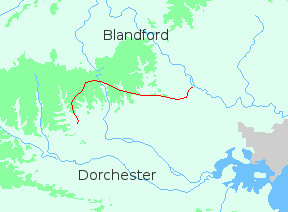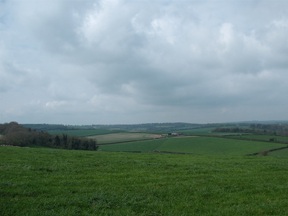
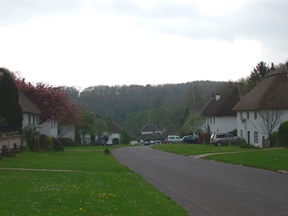
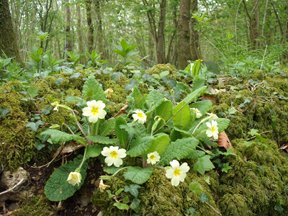
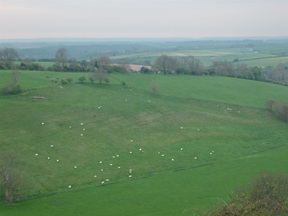
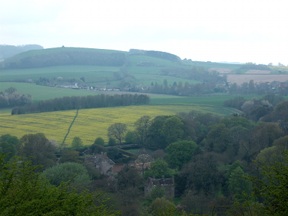
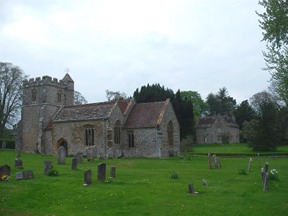
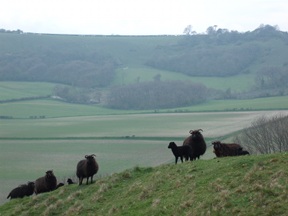
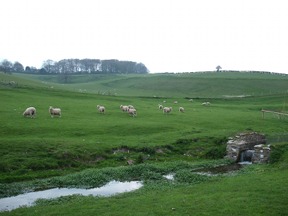
The Dorset chalk flows over the landscape in two waves. A broad swathe extends south-west from Cranbourne Chase, between the Frome valley and the Blackmore Vale. Further south another ridge, narrower and more clearly defined, runs from Studland in Purbeck to Eggardon Hill north-east of Bridport.
The northern chalk is split lengthways by the A354 between Blandford and Dorchester. Starting from Spetisbury, three miles south of Blandford, my plan was to cross the road then follow a broad, irregular arc to Dorchester, approaching the town from the north. All in all I had about twenty four miles to cover - an easy couple of days.
From Spetisbury the land inclines upwards in long, low ridges. It's not the most interesting walking, with wide fields and occasional plantations, all very much like one another. As I climbed Charlton Down I passed the Gorcombe Farm outdoor activities centre. On a serpentine track carved into the hillside quad bikes droned in dismal succession. Volleys of gunfire shook the air. The incessant noise echoing over the downs shattered the peace of the morning.
Once across the main road things improved. I entered a quiter, less populated region, where the valleys were deeper and the footpaths less direct. There was woodland too, adding to the sense of seclusion. The track dropped down to Higher Whatcombe then climbed through Whatcombe Wood up onto Hoggen Down. A name redolent of the chalk - a hog was the old name for an unshorn sheep. On the far side of the Down was Milton Abbas.
The village, in spite of its picture postcard looks, is rather sterile, with cottages fixed in repetative rows along a wide main street. It was built in 1780 by the Earl of Dorchester, who felt that the original settlement of Middleton was spoiling the view from his window and had it relocated up a side valley. There's a pub at the top end of the the village, but having satisfied the need for liquid refreshment I was not sorry to leave.
I climbed through woods where bluebells and primroses flowered in mossy beds. Then out onto the chalk once more, with fine views south over Coombe Bottom to Puddletown Forest and distant Purbeck. Crossing the ridge I descended a winding track speckled with cowslips to Bingham's Melcombe.
It consists of a church, a manor house and a few farm buildings, and looks as though it hasn't changed for centuries. I sat on a bench in the churchyard, remote from the present, listening to the silence of the downs. The only sounds were the faint drone of insects in the afternoon sunshine and the whisper of leaves stirred by the breeze. At my feet, bright-eyed and curious, a robin perched.
Presently a lady emerged from the church. In the course of conversation I mentioned that I was planning to sleep out, and she offered me the use of a barn should I have need of shelter! A kindly thought, and I would have accepted had it been later in the day. It was still too early to think of stopping, though: I needed to push on, so I thanked her and set off for the larger settlement of Melcombe Bingham.
From the village I passed south of the Dorsetshire Gap. Beyond the Gap is the Blackmore Vale - a region which is in Dorset, but not quite of it. Flat and heavy underfoot, the Vale seems more akin to the Somerset levels away to the west.
Leaving the Gap I climbed the ridge running south from Nettlecombe Tout. There I crossed the line of another walk, a journey inspired by the writings of Thomas Hardy which I called Wessex Heights. On the far side I descended Hog's Hill (another one) to Lyscombe Farm.
There's on old chapel marked on the map, next to the farm. The ruins were clearly visible, but I looked in vain for a notice board which might explain their significance. So I crossed the quiet stream and continued over Whitcombe Hill, past Hog Leaze (they're everywhere!) to Doles Hill Plantation.
I passed a comfortable night under the trees, only briefly disturbed by the dog-like bark of a roe buck and an outrageous moon climbing through the clear night sky. Neither kept me awake for very long.

